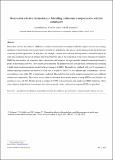Monovalent selective electrodialysis: Modelling multi-ionic transport across selective membranes
Author(s)
Rehman, Danyal; Ahdab, Yvana D; Lienhard, John H
Download2021_Rehman_et_al_Monovalent.pdf (25.23Mb)
Open Access Policy
Open Access Policy
Creative Commons Attribution-Noncommercial-Share Alike
Terms of use
Metadata
Show full item recordAbstract
Monovalent selective electrodialysis (MSED) is a variant of conventional electrodialysis (ED) that employs selective ion exchange membranes to preferentially remove monovalent ions relative to divalent ions. This process can be beneficial when the divalent rich stream has potential applications. In agriculture, for example, a stream rich in calcium and magnesium is deemed beneficial for crops and can decrease the use of fertilizers that would otherwise need to be re-introduced to the source water prior to irrigation. MSED has been used for salt production, brine concentration, and irrigation. An experimentally validated computational model to predict its performance, however, is not available in the literature. The present work uses concepts from conventional ED modelling to build a high-resolution predictive model for the performance of MSED. The model was validated with over 32 experiments at different operating conditions and observed to fit the data to within 6% and 8% for two different types of membranes. All voltage predictions were within 10% of experiments conducted. The model was then used to predict permselectivity across different salinities and compositions. These values were extended to investigate the economic benefits of using MSED to save fertilizers for greenhouses across the U.S. Results showed an average of $4991 saved per hectare when employing MSED technology. These values aligned with predictions from two previous techno-economic studies conducted investigating MSED for agriculture.
Date issued
2021-04Department
Rohsenow Kendall Heat Transfer Laboratory (Massachusetts Institute of Technology); Massachusetts Institute of Technology. Department of Mechanical EngineeringJournal
Water Research
Publisher
Elsevier BV
Citation
Rehman, Danyal et al. “Monovalent selective electrodialysis: modelling transport in multi-ionic solutions across selective membranes,” Water Research 199 (July 2021) :117171. © 2021 Elsevier Ltd.
Version: Author's final manuscript
ISSN
0043-1354